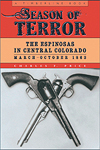
Season of Terror: The Espinosas in Central Colorado, March–October 1863, by Charles F. Price, University Press of Colorado, Boulder, 2013, $34.95
Wild West and other publications have profiled the murderous Espinosas, who struck terror for eight months 150 years ago, but now comes a book-length treatment that gives this fascinating if disturbing story its just due. Author Price has meticulously researched the short but vicious rampage of the deadly Espinosa trio—New Mexican–born brothers Felipe Nerio and José Vivián and their nephew José Vincente—but it remains uncertain how many people they killed (most likely a dozen or more, though they boasted of 32 victims). When we think of men dying violently in the Old West, we usually attribute it to gunfights (even if not of the classic Hollywood fashion), but the Espinosas didn’t want to fight—only to kill. These poor Hispanic farmers became, as Price writes in his introduction, “what we would call serial killers, a category of crime more readily associated with our own time than with the 19th-century Western frontier.”
Price details what murders (often including mutilation) he can, while considering a question with no easy answer: What motivated these three Hispanos? They did steal some, but they were primarily man-killers. They were members of the Penitentes, a lay brotherhood known for its self-torture, and have been portrayed as warriors of faith against infidels. Because they set out to “exterminate the Americans,” some sympathizers
have viewed them as social bandits or even patriotic figures resisting Anglo oppression. The two Espinosa brothers may have sought vengeance for the way Americans put down the 1847 Pueblo–New Mexican revolt or for more personal grievances. That, however, doesn’t explain why their first and last victims were Hispanos rather than the hated gringos. Price does not wholly reject any of these notions, but he concludes, “Whatever the Espinosas’ provocations, grievances or mental states, their reign of terror was in no sense justifiable and may have been inspired by no motive more complicated than criminal insanity.”
Price also has much to say about the people—lawmen, soldiers and Colorado Territory citizens—who tried to track down the Espinosas. The Territorial Legislature, Governor John Evans and relatives of murder victims offered monetary rewards. In their pursuit of immediate justice, posse members lynched one or two innocent men and tortured another. A posse led by John McCannon dispatched of José Vivián, but the other two Espinosas remained at large. Determined to end the Espinosa rampage, Fort Garland commander Colonel Samuel Tappan called on skilled tracker Tom Tobin, whom Price describes as “a man in the mythic mold of his friend Kit Carson.” With a 16-pound single-shot Hawken rifle in hand, Tobin completed his task, returning to Tappan’s quarters with a sack containing the two wanted heads. Tobin’s motivation was simple: He felt it was his duty.
Editor




